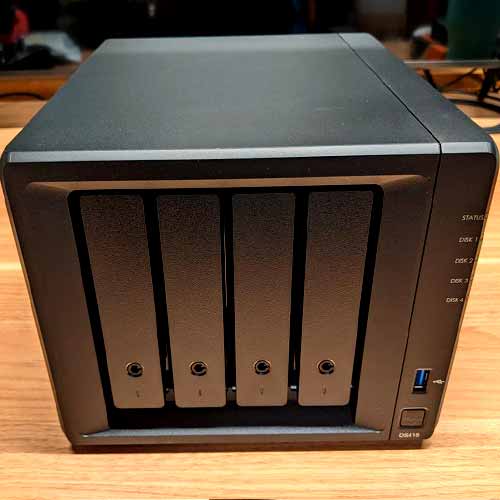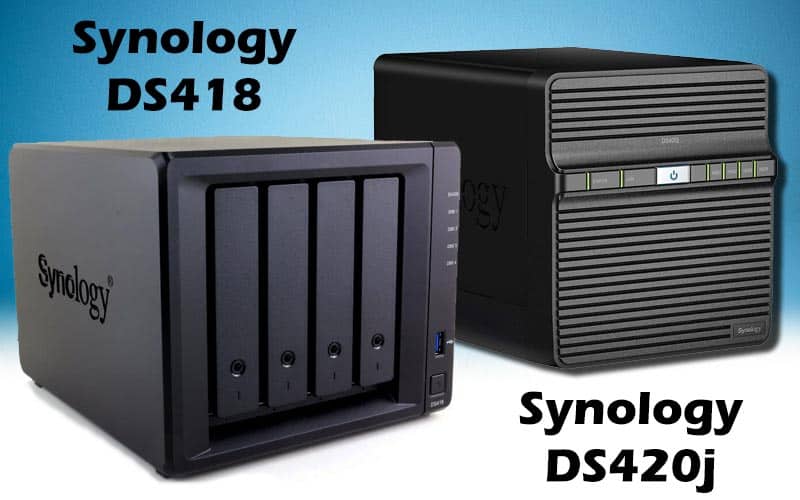Although both systems are equipped with the same processing unit, the Synology DS418 shows comparatively faster read-write speeds. With this NAS you also get a larger raw capacity, and better LAN ability.

Things you should know before moving ahead:
The Synology DS418+
- has a Quad-core processor while its peer has a Dual-core processor.
- has a greater raw capacity.
- has higher read/write speeds.
- has a more innovative design.
- is easier to install.
- is less noisy as compared to its competitor.
- is expensive
The Synology DS420j is a lightweight equipment that helps you build a personalized cloud network.
Moreover, you can store and sync data with different devices and operating systems.
Its efficient construction reduces power consumption, making it a smart tool and it also makes less noise.
On the other side, the Synology DS418 has sleek and clean look along with faster processing because it has enhanced memory as that of its competitor.
Larger raw capacity gives the freedom to store huge amount of data and sliding drive trays make the setup procedure a lot easier.
Moreover, its local networking ability is higher as with two Ethernet ports it allows link aggregation.
Table of Contents
Comparison of both NAS Devices:
| DS418 | DS420j | |
| CPU | Realtek RTD1296 quad-core 1.4GHz | Realtek RTD1296 Quad-core 1.4 GHz |
| Installed memory | 2 GB DDR4 | 1 GB DDR4 |
| RAW capacity | 48 TB | 64 TB |
| Compatible drive types | 3.5″ SATA HDD 2.5″ SATA HDD 2.5″ SATA SSD | 3.5″ SATA HDD 2.5″ SATA HDD 2.5″ SATA SSD |
| Interface | SATA III | SATA |
| External ports | 2 x USB 3.2 Gen 1 ports 2 x Rj-45 1 GbE LAN ports | 2 x USB 3.2 Gen 1 ports 1 x Rj-45 1 GbE LAN port |
Comparison of their speed:
Both these devices have Realtek RTD 1296 processors that perform at the frequency of 1.4 GHz but Synology DS418 shows better speed as it has a larger RAM.
It can store new information and sift through its database quickly, allowing fast read-write operations because spacious 2GB installed memory allows more efficient processing.
With hardware accelerated encryption its reading speed is 224 Mb/s and writing speed is 139 Mb/s while with link aggregation sequential throughput its speeds go as faster as 226 Mb/s read and 170 Mb/s write.
On the other pole, DS420 has a 1GB DDR4 RAM which makes it slower than its competitor.
Thus, its read-write speeds only go up to 112 Mb/s even with sequential encryption.
| DS418 | DS420j | |
| Read (Mbps) | 224 to 226 | 112 |
| Write (Mbps) | 139 to 170 | 112 |
Hardware and design differences
DS420j specifies a black colored NAS with a lined texture on the front view.
It is lightweight but larger in size than its competitor.
On the front side, it carries a power button and LED indicators (status, LAN, drives function) while the rear side shows GbE, USB, and power ports along with a security slot, fan exhausts, and reset button.
Features that provide it an advantage over the competitor are system fans and power consumption.
Its power rating is reported only 21.71 Watt thus; it consumes less electricity than its competitor.
Likewise, it has two cooling fans and both of them are comparatively smaller and work on low power mode as well.
In contrast, DS418 characterizes a modish and cleaner Look.
Although it is a compact device but weighs heavier in comparison.
The front view shows 4 drive bays and a marginal bar with a power button, a USB port, and status indicators.
While RJ-45 Gbe ports, Kensington slot, cooling fans, reset button, a USB 3.0, and power inlet are located on the backside.
It ranks superior with respect to hardware and design because it is more user-friendly due to hot swappable drive trays, two Ethernet ports (enables link aggregation), and an ability to work in extremely cold temperatures.
Cloud services comparison
Both storage devices enable Synology Drive to store NAS files online and share them across various platforms.
This data can be approached via the desktop portal or iOS and Android applications of Synology Drive, DS photo/audio/note/file, and Moments.
It enables data transmission with a larger number of public cloud services including OneDrive, Dropbox, Google Drive, Alibaba Cloud OSS, S3, Baidu, and others.
DS418 gets the edge over its competitor as it provides a larger storage capacity than its competitor.
With 64TB raw capacity, you can keep a lot more data on this NAS.
In comparison, DS420j has a lesser score for storage volume as it only offers 48 TB to build a personalized cloud database.
Supported Operating Systems and browsers
Both these NAS devices are compatible with macOS X 10.11/onwards and Windows 7, 10/onwards, enabling the majority of users to work conveniently through its cloud network.
Multimedia files can be shared and synced across Linux, macOS, Windows, iOS, and Android systems with Cloud Station Suite.
Many web browsers namely Firefox, Edge, Chrome, Internet Explorer, Safari 10, iOS 10, and Android 6.0 are operate-able with these systems.
which has better Backup and Sharing?
Both systems employ Hyper Backup technology integrating cross-version deduplication, block-level incremental data backup, and scheduled integrity checks along with AES encryption.
Moreover, Synology Hybrid RAID (SHR) makes these devices very competent for local backups.
Each of these devices shows 2 disk fault tolerance as various RAID modes enable efficient mirroring.
The backup service is timely updated via cloud sync.
DS418 shows a better performance in terms of backup and sharing due to its higher file sharing capability.
It simultaneously allows up to 2408 local user accounts and can make 200 concurrent AFP/SMB/NFS/FTP connections.
Conversely, DS420j has a lesser capability for file-sharing because on maximum, 1024 local user accounts can operate. Similarly, the maximum number of concurrent connections is just 100; half as that of its competitor.
How to set up these devices?
It is relatively difficult to set up DS420j because drive trays are not hot-swappable and you have to open the device to load up the disks onto the system.
- Open up the screw at the back panel. Push and lift the upper case to remove it.
- Use the screwdriver to install the 2.5’’ or 3.5’’ disks onto the drive trays.
- Reposition the upper case and tighten the back screws to fix it in its place.
- Connect the device with a power supply and local network through a router or computer.
- Access the “Web Assistant” of Synology through a web browser to configure it DiskStation Manager (DSM) which is essentially a browser-based operating system.
DS418 is more user-friendly as its setup procedure is relatively easier. Its hard disk drives are easily swappable from the front side and you don’t have to disassemble the whole device for mounting disks on drive trays.
- Press on the drive tray lock and pull it out.
- Place HDD or SDD and anchor it with screws.
- Slide the tray into the drive bay to remount it.
- Power up the device and use web assistant to access DSM.
Does DS418 produce more Noise?
Synology systems produce notable noise because both of them have two cooling fans, causing loud mechanical sounds.
DS420j is a quieter device in comparison and produces 20.6 dB sound while working.
The little difference is due to the relatively smaller size of the fans.
DS418 marks the noise scale at 20.9 decibels and stands comparatively louder as its big fans produce more noise.
Are these devices expensive?
DS420j comes cheaper yet it offers a good storage volume and a reliable working speed.
In contrast, DS418 is priced higher but provides massive storage capacity, faster processing, and ease of drive-installation with swappable trays in return.


